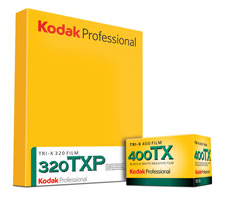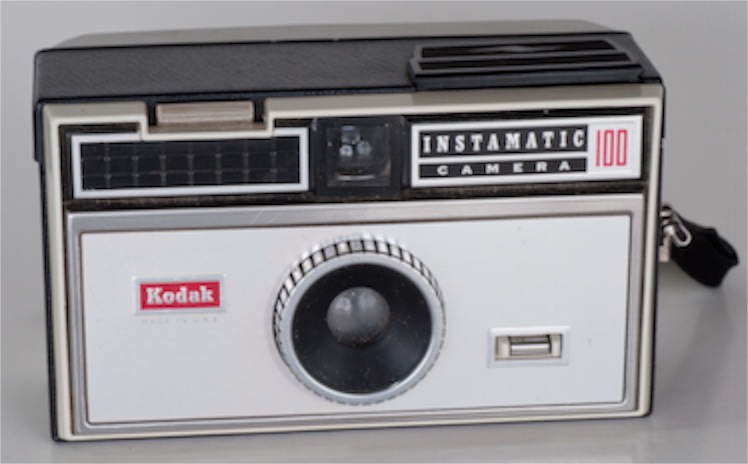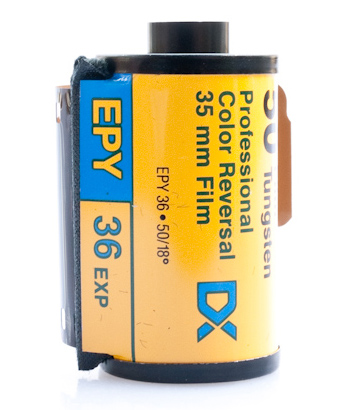No more Kodak?
06/01/12 05:18
If you think that things always stay the same, here is one for you: Shares of Kodak stock could be bought for 47 cents yesterday on the New York Stock Exchange. Imagine a hundred shares for less than $50! But at this price, don’t expect them to last. It isn’t that higher share prices are in store for the company. It is that the New York Stock Exchange has warned that it is going to delist Kodak if the price remains below $1 for the next six months.
It is going to take some adjustment to think of a world without the iconic Kodak brand name. It wasn’t that long ago that I couldn’t imagine photography without Kodak. Before getting into digital photography, I was purchasing Kodak Tri-x and Ektachrome film in 100’ rolls and transferring it to cartridges for my cameras. In the decades when we had our own darkroom in our basement, I couldn’t have imagined a darkroom without the yellow Kodak boxes of paper and the packets of toners and other chemicals with the Kodak name on them.

Kodak didn’t invent photography. In the late 1830’s Louis Daguerre and William Fox Talbot captured images using silvered copper plates and later paper coated with silver iodide. But the process was very expensive. It was a hobby for the wealthy for many years until Kodak entered the scene. In 1900 they introduced the ‘box Brownie’ camera. The camera sold for $1 and the film for 15 cents per roll. Those were significant prices in those days, but far less than the larger sheet film cameras that preceded the brownie. Suddenly photography was accessible to ordinary citizens. Kodak continued with the innovations, including the instamatic cameras of my youth and teenage years.

Kodak continued to be a company of innovations. Their Rochester, New York, Research Park was one of the 20th Century’s great centers of scientific discovery and innovation.
The great magazines of the 20th Century, including Time, Newsweek and National Geographic couldn’t have emerged without Kodak film. Kodachrome, the company’s color print film introduced in 1935 was the only film used by National Geographic photographers for decades. Stored properly, Kodachrome didn’t fade. It produced the sharpest, most natural color of any film ever produced.
In the world of digital photography, Kodachrome became a dinosaur. The final extinction occurred just over a year ago when Dwayne’s Photo in Parsons, Kansas developed the last roll of the film.

There are some who will claim that the fall of Kodak was caused by the development of digital photography, but that is just too simple to tell the whole story. To say that is to ignore the fact that Kodak is the company that started the digital photography revolution. The first digital camera available to the public was a Kodak. The company invested heavily in digital products, including a series of cameras and printers that worked together to enable average citizens to produce quality color prints in their homes for pennies a copy. Kodak digital was a factor in the fall of competitor Polaroid, who prior to digital cameras had held exclusive patents for instant photography processes.
The rate of change in our world makes it hard for any giant company to be responsive enough to stay on top. The current tsunami of change requires a flexibility and adaptability that is rarely possible in a large corporate environment. It is almost as any company that is successful enough to make it to the top is destined to become too inflexible to keep up with the change. It wasn’t the advent of digital photography that did in Kodak, it was its business model. The demise didn’t come from the labs, but from the boardroom.
An excellent example was the offering of 1100 digital imaging patents for sale in July. At the time these patents were believed to be extremely valuable. The estimate was that they could bring between $2 billion and $3 billion. But there were no customers. The competition wasn’t interested in buying Kodak’s patents – they had been forced to come up with their own ideas and their own patents. Upstart companies couldn’t afford the expensive patents – they were forced to bank on innovation, not on existing ideas.
Meanwhile, Kodak corporation couldn’t quite believe that people would quit wanting prints of their photographs. It is hard for us old timers to wrap our heads around the fact that our children share photographs with cell phones and digital frames, on Facebook and other Internet sites. They don’t have boxes and drawers of printed photographs like we do. Their albums are digital and stored in the cloud, not bound and stored on bookshelves.
The world is changing. And though a nostalgic old timer like myself can shake his head and say, “It’ll never be the same,” those sentiments don’t change the reality. My grandchildren will grow up knowing of Kodak only from their grandfather’s ruminations or perhaps a visit to a museum some day – and the museum will, of course, not be a physical place, but an Internet site with digital displays. Maybe there will be an interactive display where a touchscreen or trackpad will be used to simulate the feel of touching the shutter on an old-time film camera.
The downfall of Kodak hits close to home not just because I have enjoyed photography over the decades and have purchased a lot of Kodak products. It hits close to home because it is just one more sign that institutions crumble with time. And I have staked my career on an institution that itself is in decline. The statistics about churches and church participation can be interpreted to project trend lines that are not dissimilar to those at large corporations such as Kodak. There is no guarantee that the United Church of Christ will be a recognizable “brand name” for future generations any more than Kodak.
The church of Jesus Christ, however, is far more than an institution. The corporate entities can fail. The human-built institutions can crumble. But the word of the Lord is forever. Faith, hope and love will not disappear from this world. Still we ignore change at our own peril.
I cannot imagine the future, just like I still cannot imagine a world without Kodak.
The good news is that the future is not in my hands. The future is in God’s hands.
It is going to take some adjustment to think of a world without the iconic Kodak brand name. It wasn’t that long ago that I couldn’t imagine photography without Kodak. Before getting into digital photography, I was purchasing Kodak Tri-x and Ektachrome film in 100’ rolls and transferring it to cartridges for my cameras. In the decades when we had our own darkroom in our basement, I couldn’t have imagined a darkroom without the yellow Kodak boxes of paper and the packets of toners and other chemicals with the Kodak name on them.

Kodak didn’t invent photography. In the late 1830’s Louis Daguerre and William Fox Talbot captured images using silvered copper plates and later paper coated with silver iodide. But the process was very expensive. It was a hobby for the wealthy for many years until Kodak entered the scene. In 1900 they introduced the ‘box Brownie’ camera. The camera sold for $1 and the film for 15 cents per roll. Those were significant prices in those days, but far less than the larger sheet film cameras that preceded the brownie. Suddenly photography was accessible to ordinary citizens. Kodak continued with the innovations, including the instamatic cameras of my youth and teenage years.

Kodak continued to be a company of innovations. Their Rochester, New York, Research Park was one of the 20th Century’s great centers of scientific discovery and innovation.
The great magazines of the 20th Century, including Time, Newsweek and National Geographic couldn’t have emerged without Kodak film. Kodachrome, the company’s color print film introduced in 1935 was the only film used by National Geographic photographers for decades. Stored properly, Kodachrome didn’t fade. It produced the sharpest, most natural color of any film ever produced.
In the world of digital photography, Kodachrome became a dinosaur. The final extinction occurred just over a year ago when Dwayne’s Photo in Parsons, Kansas developed the last roll of the film.

There are some who will claim that the fall of Kodak was caused by the development of digital photography, but that is just too simple to tell the whole story. To say that is to ignore the fact that Kodak is the company that started the digital photography revolution. The first digital camera available to the public was a Kodak. The company invested heavily in digital products, including a series of cameras and printers that worked together to enable average citizens to produce quality color prints in their homes for pennies a copy. Kodak digital was a factor in the fall of competitor Polaroid, who prior to digital cameras had held exclusive patents for instant photography processes.
The rate of change in our world makes it hard for any giant company to be responsive enough to stay on top. The current tsunami of change requires a flexibility and adaptability that is rarely possible in a large corporate environment. It is almost as any company that is successful enough to make it to the top is destined to become too inflexible to keep up with the change. It wasn’t the advent of digital photography that did in Kodak, it was its business model. The demise didn’t come from the labs, but from the boardroom.
An excellent example was the offering of 1100 digital imaging patents for sale in July. At the time these patents were believed to be extremely valuable. The estimate was that they could bring between $2 billion and $3 billion. But there were no customers. The competition wasn’t interested in buying Kodak’s patents – they had been forced to come up with their own ideas and their own patents. Upstart companies couldn’t afford the expensive patents – they were forced to bank on innovation, not on existing ideas.
Meanwhile, Kodak corporation couldn’t quite believe that people would quit wanting prints of their photographs. It is hard for us old timers to wrap our heads around the fact that our children share photographs with cell phones and digital frames, on Facebook and other Internet sites. They don’t have boxes and drawers of printed photographs like we do. Their albums are digital and stored in the cloud, not bound and stored on bookshelves.
The world is changing. And though a nostalgic old timer like myself can shake his head and say, “It’ll never be the same,” those sentiments don’t change the reality. My grandchildren will grow up knowing of Kodak only from their grandfather’s ruminations or perhaps a visit to a museum some day – and the museum will, of course, not be a physical place, but an Internet site with digital displays. Maybe there will be an interactive display where a touchscreen or trackpad will be used to simulate the feel of touching the shutter on an old-time film camera.
The downfall of Kodak hits close to home not just because I have enjoyed photography over the decades and have purchased a lot of Kodak products. It hits close to home because it is just one more sign that institutions crumble with time. And I have staked my career on an institution that itself is in decline. The statistics about churches and church participation can be interpreted to project trend lines that are not dissimilar to those at large corporations such as Kodak. There is no guarantee that the United Church of Christ will be a recognizable “brand name” for future generations any more than Kodak.
The church of Jesus Christ, however, is far more than an institution. The corporate entities can fail. The human-built institutions can crumble. But the word of the Lord is forever. Faith, hope and love will not disappear from this world. Still we ignore change at our own peril.
I cannot imagine the future, just like I still cannot imagine a world without Kodak.
The good news is that the future is not in my hands. The future is in God’s hands.